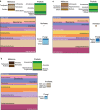Organic carbon transformations in high-Arctic peat soils: key functions and microorganisms
- PMID: 22955232
- PMCID: PMC3554415
- DOI: 10.1038/ismej.2012.99
Organic carbon transformations in high-Arctic peat soils: key functions and microorganisms
Abstract
A substantial part of the Earths' soil organic carbon (SOC) is stored in Arctic permafrost peatlands, which represent large potential sources for increased emissions of the greenhouse gases CH(4) and CO(2) in a warming climate. The microbial communities and their genetic repertoire involved in the breakdown and mineralisation of SOC in these soils are, however, poorly understood. In this study, we applied a combined metagenomic and metatranscriptomic approach on two Arctic peat soils to investigate the identity and the gene pool of the microbiota driving the SOC degradation in the seasonally thawed active layers. A large and diverse set of genes encoding plant polymer-degrading enzymes was found, comparable to microbiotas from temperate and subtropical soils. This indicates that the metabolic potential for SOC degradation in Arctic peat is not different from that of other climatic zones. The majority of these genes were assigned to three bacterial phyla, Actinobacteria, Verrucomicrobia and Bacteroidetes. Anaerobic metabolic pathways and the fraction of methanogenic archaea increased with peat depth, evident for a gradual transition from aerobic to anaerobic lifestyles. A population of CH(4)-oxidising bacteria closely related to Methylobacter tundripaludum was the dominating active group of methanotrophs. Based on the in-depth characterisation of the microbes and their genes, we conclude that these Arctic peat soils will turn into CO(2) sources owing to increased active layer depth and prolonged growing season. However, the extent of future CH(4) emissions will critically depend on the response of the methanotrophic bacteria.
Figures




Similar articles
-
Metatranscriptomic analysis of arctic peat soil microbiota.Appl Environ Microbiol. 2014 Sep;80(18):5761-72. doi: 10.1128/AEM.01030-14. Epub 2014 Jul 11. Appl Environ Microbiol. 2014. PMID: 25015892 Free PMC article.
-
Genomic insights into redox-driven microbial processes for carbon decomposition in thawing Arctic soils and permafrost.mSphere. 2024 Jul 30;9(7):e0025924. doi: 10.1128/msphere.00259-24. Epub 2024 Jun 11. mSphere. 2024. PMID: 38860762 Free PMC article.
-
Metabolic and trophic interactions modulate methane production by Arctic peat microbiota in response to warming.Proc Natl Acad Sci U S A. 2015 May 12;112(19):E2507-16. doi: 10.1073/pnas.1420797112. Epub 2015 Apr 27. Proc Natl Acad Sci U S A. 2015. PMID: 25918393 Free PMC article.
-
Diversity of Methane Cycling Microorganisms in Soils and Their Relation to Oxygen.Curr Issues Mol Biol. 2019;33:23-56. doi: 10.21775/cimb.033.023. Epub 2019 Jun 5. Curr Issues Mol Biol. 2019. PMID: 31166184 Review.
-
Dynamics of microbial communities and CO2 and CH4 fluxes in the tundra ecosystems of the changing Arctic.J Microbiol. 2019 May;57(5):325-336. doi: 10.1007/s12275-019-8661-2. Epub 2019 Jan 16. J Microbiol. 2019. PMID: 30656588 Review.
Cited by
-
Life at the Frozen Limit: Microbial Carbon Metabolism Across a Late Pleistocene Permafrost Chronosequence.Front Microbiol. 2020 Jul 29;11:1753. doi: 10.3389/fmicb.2020.01753. eCollection 2020. Front Microbiol. 2020. PMID: 32849382 Free PMC article.
-
Metagenomic insights into microbial community structure and metabolism in alpine permafrost on the Tibetan Plateau.Nat Commun. 2024 Jul 14;15(1):5920. doi: 10.1038/s41467-024-50276-2. Nat Commun. 2024. PMID: 39004662 Free PMC article.
-
Forest floor community metatranscriptomes identify fungal and bacterial responses to N deposition in two maple forests.Front Microbiol. 2015 Apr 23;6:337. doi: 10.3389/fmicb.2015.00337. eCollection 2015. Front Microbiol. 2015. PMID: 25954263 Free PMC article.
-
Response of Methanogens in Arctic Sediments to Temperature and Methanogenic Substrate Availability.PLoS One. 2015 Jun 17;10(6):e0129733. doi: 10.1371/journal.pone.0129733. eCollection 2015. PLoS One. 2015. PMID: 26083466 Free PMC article.
-
Metatranscriptomics reveals a differential temperature effect on the structural and functional organization of the anaerobic food web in rice field soil.Microbiome. 2018 Sep 19;6(1):169. doi: 10.1186/s40168-018-0546-9. Microbiome. 2018. PMID: 30231929 Free PMC article.
References
-
- Alves RJE.2011Ammonia-oxidizing archaea from High Arctic soilsMaster thesis, University of Lisbon: Lisbon, Portugal
-
- Berg MP, Bengtsson J. Temporal and spatial variability in soil food web structure. Oikos. 2007;116:1789–1804.
-
- Cao M, Marshall S, Gregson K. Global carbon exchange and methane emissions from natural wetlands: application of a process-based model. J Geophys Res. 1996;101:399–414.

